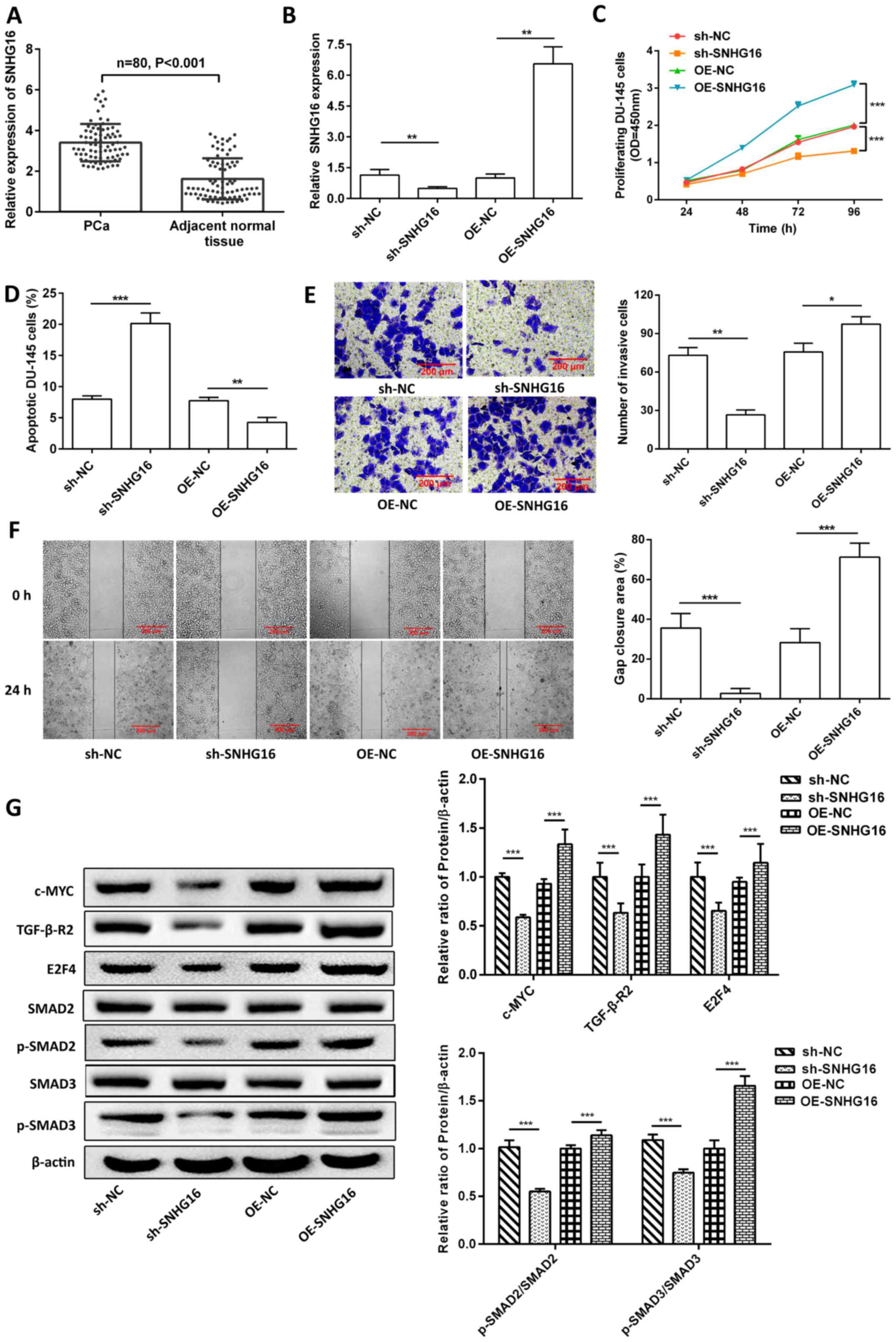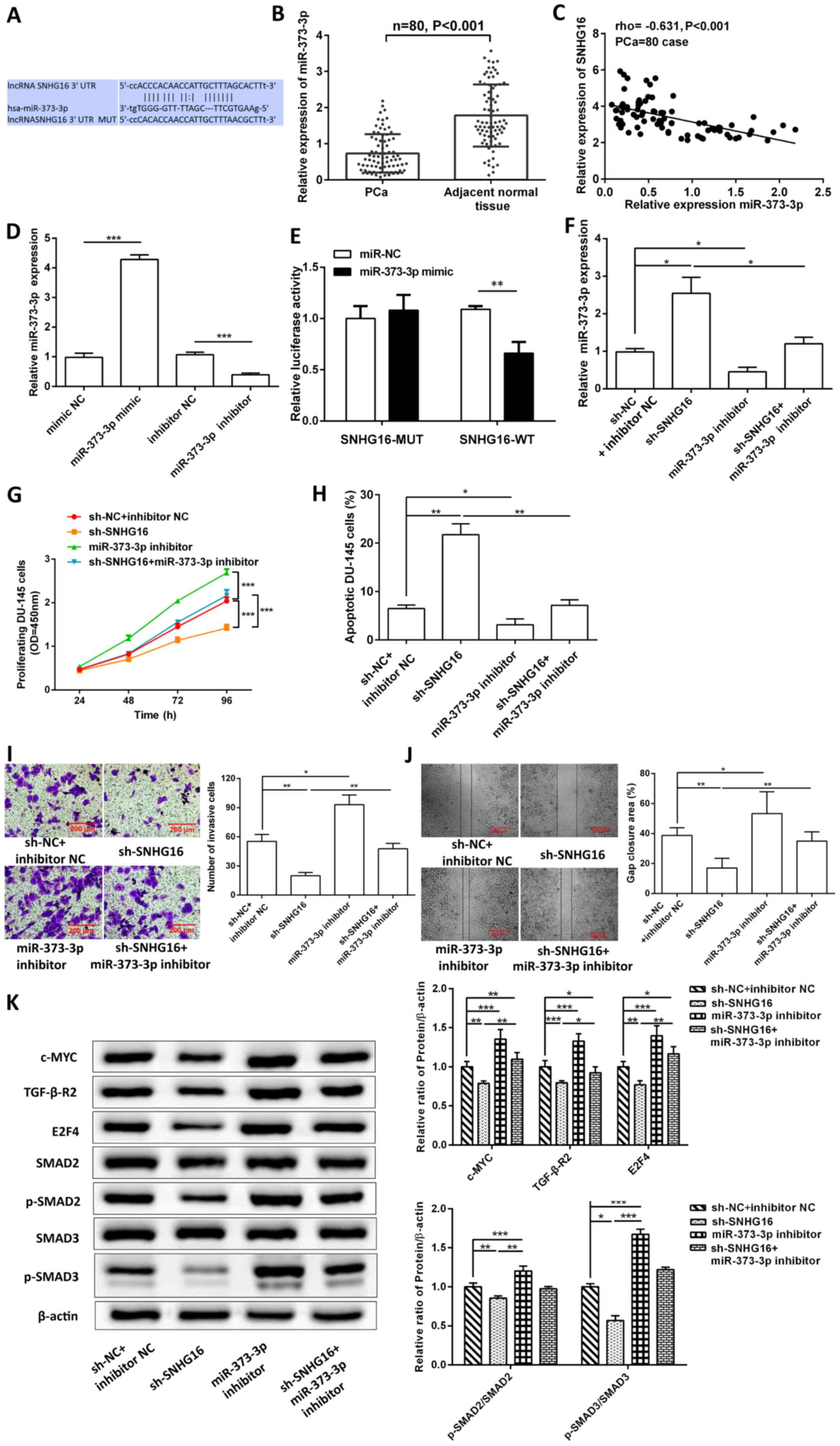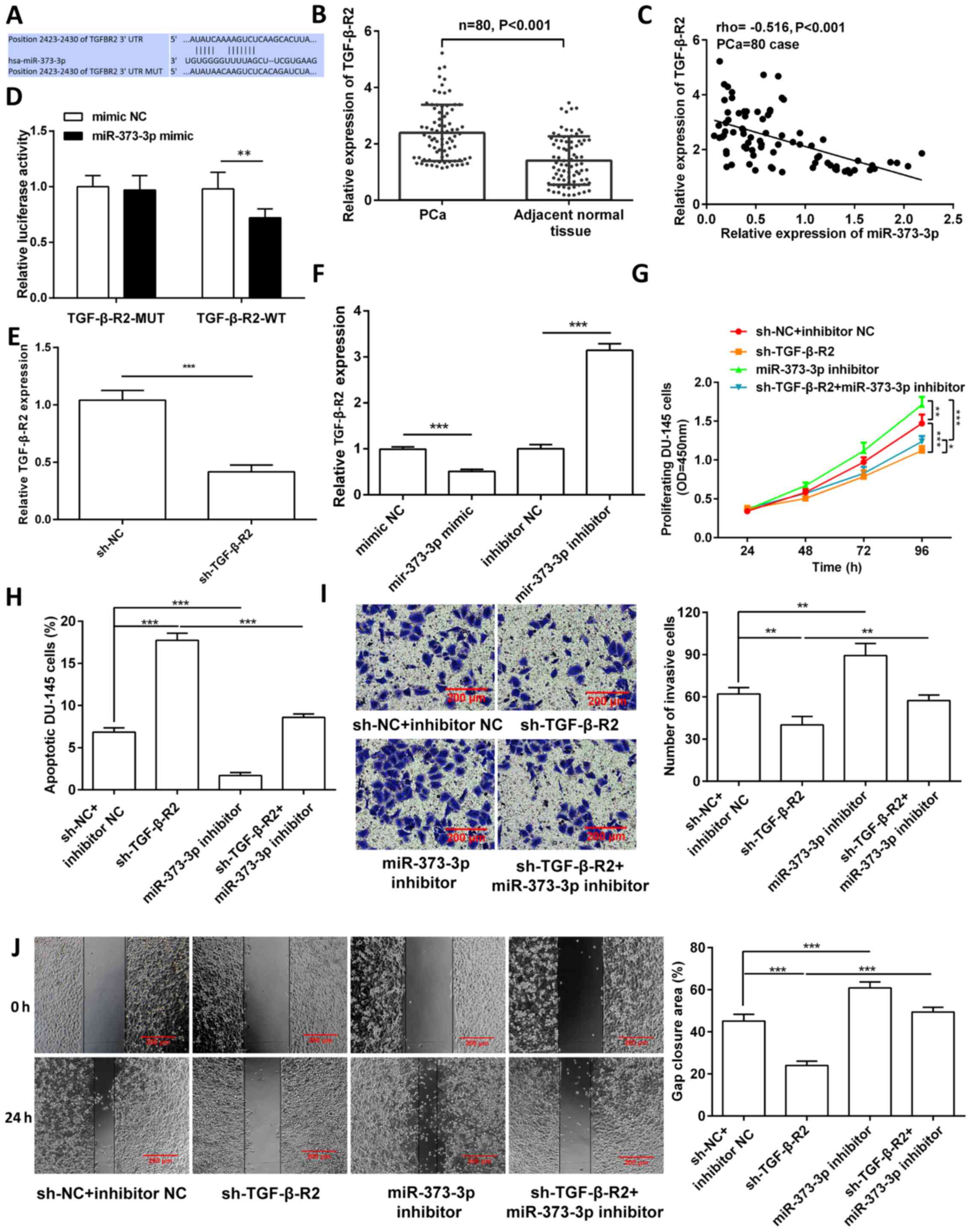|
1
|
Pishgar F, Ebrahimi H, Saeedi Moghaddam S,
Fitzmaurice C and Amini E: Global, regional and national burden of
prostate cancer, 1990 to 2015: Results from the global burden of
Disease Study 2015. J Urol. 199:1224–1232. 2018. View Article : Google Scholar
|
|
2
|
Litwin MS and Tan HJ: The diagnosis and
treatment of prostate cancer: A review. JAMA. 317:2532–2542. 2017.
View Article : Google Scholar
|
|
3
|
Siegel RL, Miller KD and Jemal A: Cancer
statistics, 2017. CA Cancer J Clin. 67:7–30. 2017. View Article : Google Scholar
|
|
4
|
Siegel RL, Miller KD and Jemal A: Cancer
statistics, 2020. CA Cancer J Clin. 70:7–30. 2020. View Article : Google Scholar
|
|
5
|
Arora K and Barbieri CE: Molecular
subtypes of prostate cancer. Curr Oncol Rep. 20:582018. View Article : Google Scholar
|
|
6
|
Hua JT, Chen S and He HH: Landscape of
noncoding RNA in prostate cancer. Trends Genet. 35:840–851. 2019.
View Article : Google Scholar
|
|
7
|
Dragomir MP, Kopetz S, Ajani JA and Calin
GA: Non-coding RNAs in GI cancers: From cancer hallmarks to
clinical utility. Gut. 69:748–763. 2020. View Article : Google Scholar
|
|
8
|
Ponting CP, Oliver PL and Reik W:
Evolution and functions of long noncoding RNAs. Cell. 136:629–641.
2009. View Article : Google Scholar
|
|
9
|
Lingadahalli S, Jadhao S, Sung YY, Chen M,
Hu L, Chen X and Cheung E: Novel lncRNA LINC00844 regulates
prostate cancer cell migration and invasion through AR signaling.
Mol Cancer Res. 16:1865–1878. 2018. View Article : Google Scholar
|
|
10
|
Gu P, Chen X, Xie R, Han J, Xie W, Wang B,
Dong W, Chen C, Yang M, Jiang J, et al: lncRNA HOXD-AS1 regulates
proliferation and chemo-resistance of castration-resistant prostate
cancer via recruiting WDR5. Mol Ther. 25:1959–1973. 2017.
View Article : Google Scholar
|
|
11
|
Salameh A, Lee AK, Cardó-Vila M, Nunes DN,
Efstathiou E, Staquicini FI, Dobroff AS, Marchiò S, Navone NM,
Hosoya H, et al: PRUNE2 is a human prostate cancer suppressor
regulated by the intronic long noncoding RNA PCA3. Proc Natl Acad
Sci USA. 112:8403–8408. 2015. View Article : Google Scholar
|
|
12
|
Liao W and Zhang Y: MicroRNA-381
facilitates autophagy and apoptosis in prostate cancer cells via
inhibiting the RELN-mediated PI3K/AKT/mTOR signaling pathway. Life
Sci. 254:1176722020. View Article : Google Scholar
|
|
13
|
Bhatia V, Yadav A, Tiwari R, Nigam S, Goel
S, Carskadon S, Gupta N, Goel A, Palanisamy N and Ateeq B:
Epigenetic silencing of miRNA-338-5p and miRNA-421 drives
SPINK1-positive prostate cancer. Clin Cancer Res. 25:2755–2768.
2019.
|
|
14
|
Lee YS and Dutta A: MicroRNAs in cancer.
Annu Rev Pathol. 4:199–227. 2009. View Article : Google Scholar
|
|
15
|
Rupaimoole R and Slack FJ: MicroRNA
therapeutics: Towards a new era for the management of cancer and
other diseases. Nat Rev Drug Discov. 16:203–222. 2017. View Article : Google Scholar
|
|
16
|
He JH, Han ZP, Zou MX, Wang L, Lv YB, Zhou
JB, Cao MR and Li YG: Analyzing the LncRNA, miRNA, and mRNA
regulatory network in prostate cancer with bioinformatics software.
J Comput Biol. 25:146–157. 2018. View Article : Google Scholar
|
|
17
|
Christensen LL, True K, Hamilton MP,
Nielsen MM, Damas ND, Damgaard CK, Ongen H, Dermitzakis E, Bramsen
JB, Pedersen JS, et al: SNHG16 is regulated by the Wnt pathway in
colorectal cancer and affects genes involved in lipid metabolism.
Mol Oncol. 10:1266–1282. 2016. View Article : Google Scholar
|
|
18
|
Zhu H, Zeng Y, Zhou CC and Ye W:
SNHG16/miR-216-5p/ZEB1 signal pathway contributes to the
tumorigenesis of cervical cancer cells. Arch Biochem Biophys.
637:1–8. 2018. View Article : Google Scholar
|
|
19
|
Zhong JH, Xiang X, Wang YY, Liu X, Qi LN,
Luo CP, Wei WE, You XM, Ma L, Xiang BD, et al: The lncRNA SNHG16
affects prognosis in hepatocellular carcinoma by regulating p62
expression. J Cell Physiol. 235:1090–1102. 2020. View Article : Google Scholar
|
|
20
|
Zhou XY, Liu H, Ding ZB, Xi HP and Wang
GW: lncRNA SNHG16 promotes glioma tumorigenicity through
miR-373/EGFR axis by activating PI3K/AKT pathway. Genomics.
112:1021–1029. 2020. View Article : Google Scholar
|
|
21
|
Shao M, Yu Z and Zou J: LncRNA-SNHG16
silencing inhibits prostate carcinoma cell growth, downregulate
GLUT1 expression and reduce glucose uptake. Cancer Manag Res.
12:1751–1757. 2020. View Article : Google Scholar
|
|
22
|
Tang Z, Xu Z, Zhu X and Zhang J: New
insights into molecules and pathways of cancer metabolism and
therapeutic implications. Cancer Commun (Lond). 41:16–36. 2021.
View Article : Google Scholar
|
|
23
|
Yang M and Wei W: SNHG16: A novel long-non
coding RNA in human cancers. OncoTargets Ther. 12:11679–11690.
2019. View Article : Google Scholar
|
|
24
|
Zhao W, Fu H, Zhang S, Sun S and Liu Y:
LncRNA SNHG16 drives proliferation, migration, and invasion of
hemangioma endothelial cell through modulation of miR-520d-3p/STAT3
axis. Cancer Med. 7:3311–3320. 2018. View Article : Google Scholar
|
|
25
|
Albini A, Bruno A, Noonan DM and Mortara
L: Contribution to tumor angiogenesis from innate immune cells
within the tumor microenvironment: Implications for immunotherapy.
Front Immunol. 9:5272018. View Article : Google Scholar
|
|
26
|
Qiu X, Zhu J, Sun Y, Fan K, Yang DR, Li G,
Yang G and Chang C: TR4 nuclear receptor increases prostate cancer
invasion via decreasing the miR-373-3p expression to alter
TGFβR2/p-Smad3 signals. Oncotarget. 6:15397–15409. 2015. View Article : Google Scholar
|
|
27
|
Pang J, Dai L, Zhang C and Zhang Q:
MiR-373 inhibits the epithelial-mesenchymal transition of prostatic
cancer via targeting runt-related transcription factor 2. J Healthc
Eng. 2021:69742252021. View Article : Google Scholar
|
|
28
|
Lu Y, Li X, Zuo Y, Xu Q, Liu L, Wu H, Chen
L, Zhang Y, Liu Y and Li Y: miR-373-3p inhibits
epithelial-mesenchymal transition via regulation of TGFβR2 in
choriocarcinoma. J Obstet Gynaecol Res. 47:2417–2432. 2021.
View Article : Google Scholar
|
|
29
|
Wei F, Cao C, Xu X and Wang J: Diverse
functions of miR-373 in cancer. J Transl Med. 13:1622015.
View Article : Google Scholar
|
|
30
|
Weng J, Zhang H, Wang C, Liang J, Chen G,
Li W, Tang H and Hou J: miR-373-3p targets DKK1 to promote
EMT-induced metastasis via the Wnt/β-catenin pathway in tongue
squamous cell carcinoma. BioMed Res Int. 2017:60109262017.
View Article : Google Scholar
|
|
31
|
Seol HS, Akiyama Y, Shimada S, Lee HJ, Kim
TI, Chun SM, Singh SR and Jang SJ: Epigenetic silencing of
microRNA-373 to epithelial-mesenchymal transition in non-small cell
lung cancer through IRAK2 and LAMP1 axes. Cancer Lett. 353:232–241.
2014. View Article : Google Scholar
|
|
32
|
Zhu B and Kyprianou N: Transforming growth
factor beta and prostate cancer. Cancer Treat Res. 126:157–173.
2005. View Article : Google Scholar
|
|
33
|
Zhao W, Zhu Q, Tan P, Ajibade A, Long T,
Long W, Li Q, Liu P, Ning B, Wang HY, et al: Tgfbr2 inactivation
facilitates cellular plasticity and development of Pten-null
prostate cancer. J Mol Cell Biol. 10:316–330. 2018. View Article : Google Scholar
|
|
34
|
Ma G, Tang M, Wu Y, Xu X, Pan F and Xu R:
LncRNAs and miRNAs: Potential biomarkers and therapeutic targets
for prostate cancer. Am J Transl Res. 8:5141–5150. 2016.
|
|
35
|
Moris L, Cumberbatch MG, Van den Broeck T,
Gandaglia G, Fossati N, Kelly B, Pal R, Briers E, Cornford P, De
Santis M, et al: Benefits and risks of primary treatments for
high-risk localized and locally advanced prostate cancer: An
international multidisciplinary systematic review. Eur Urol.
77:614–627. 2020. View Article : Google Scholar
|
|
36
|
Maruyama T, Nishihara K, Umikawa M,
Arasaki A, Nakasone T, Nimura F, Matayoshi A, Takei K, Nakachi S,
Kariya KI, et al: MicroRNA-196a-5p is a potential prognostic marker
of delayed lymph node metastasis in early-stage tongue squamous
cell carcinoma. Oncol Lett. 15:2349–2363. 2018.
|
|
37
|
Prensner JR, Iyer MK, Sahu A, Asangani IA,
Cao Q, Patel L, Vergara IA, Davicioni E, Erho N, Ghadessi M, et al:
The long noncoding RNA SChLAP1 promotes aggressive prostate cancer
and antagonizes the SWI/SNF complex. Nat Genet. 45:1392–1398. 2013.
View Article : Google Scholar
|
|
38
|
Yu M, Ohira M, Li Y, Niizuma H, Oo ML, Zhu
Y, Ozaki T, Isogai E, Nakamura Y, Koda T, et al: High expression of
ncRAN, a novel non-coding RNA mapped to chromosome 17q25.1, is
associated with poor prognosis in neuroblastoma. Int J Oncol.
34:931–938. 2009.
|
|
39
|
Lian D, Amin B, Du D and Yan W: Enhanced
expression of the long non-coding RNA SNHG16 contributes to gastric
cancer progression and metastasis. Cancer Biomark. 21:151–160.
2017. View Article : Google Scholar
|
|
40
|
Yang XS, Wang GX and Luo L: Long
non-coding RNA SNHG16 promotes cell growth and metastasis in
ovarian cancer. Eur Rev Med Pharmacol Sci. 22:616–622. 2018.
|
|
41
|
Xiao Y, Xiao T, Ou W, Wu Z, Wu J, Tang J,
Tian B, Zhou Y, Su M and Wang W: LncRNA SNHG16 as a potential
biomarker and therapeutic target in human cancers. Biomark Res.
8:412020. View Article : Google Scholar
|
|
42
|
Qi P, Xu MD, Ni SJ, Shen XH, Wei P, Huang
D, Tan C, Sheng WQ, Zhou XY and Du X: Down-regulation of ncRAN, a
long non-coding RNA, contributes to colorectal cancer cell
migration and invasion and predicts poor overall survival for
colorectal cancer patients. Mol Carcinog. 54:742–750. 2015.
View Article : Google Scholar
|
|
43
|
Xu F, Zha G, Wu Y, Cai W and Ao J:
Overexpressing lncRNA SNHG16 inhibited HCC proliferation and
chemoresistance by functionally sponging hsa-miR-93. OncoTargets
Ther. 11:8855–8863. 2018. View Article : Google Scholar
|
|
44
|
Qi JC, Yang Z, Zhang YP, Lu BS, Yin YW,
Liu KL, Xue WY, Qu CB and Li W: miR-20b-5p, TGFBR2, and E2F1 form a
regulatory loop to participate in epithelial to mesenchymal
transition in prostate cancer. Front Oncol. 9:15352020. View Article : Google Scholar
|
|
45
|
Liu JJ, Zhang X and Wu XH: miR-93 promotes
the growth and invasion of prostate cancer by upregulating its
target genes TGFBR2, ITGB8, and LATS2. Mol Ther Oncolytics.
11:14–19. 2018. View Article : Google Scholar
|
|
46
|
Xu W, Zeng F, Li S, Li G, Lai X, Wang QJ
and Deng F: Crosstalk of protein kinase C ε with Smad2/3 promotes
tumor cell proliferation in prostate cancer cells by enhancing
aerobic glycolysis. Cell Mol Life Sci. 75:4583–4598. 2018.
View Article : Google Scholar
|
|
47
|
Yang F, Strand DW and Rowley DR:
Fibroblast growth factor-2 mediates transforming growth factor-beta
action in prostate cancer reactive stroma. Oncogene. 27:450–459.
2008. View Article : Google Scholar
|
|
48
|
Yang J, Song K, Krebs TL, Jackson MW and
Danielpour D: Rb/E2F4 and Smad2/3 link survivin to TGF-beta-induced
apoptosis and tumor progression. Oncogene. 27:5326–5338. 2008.
View Article : Google Scholar
|
|
49
|
Waghray A, Schober M, Feroze F, Yao F,
Virgin J and Chen YQ: Identification of differentially expressed
genes by serial analysis of gene expression in human prostate
cancer. Cancer Res. 61:4283–4286. 2001.
|
|
50
|
DuPree EL, Mazumder S and Almasan A:
Genotoxic stress induces expression of E2F4, leading to its
association with p130 in prostate carcinoma cells. Cancer Res.
64:4390–4393. 2004. View Article : Google Scholar
|
|
51
|
Littler S, Sloss O, Geary B, Pierce A,
Whetton AD and Taylor SS: Oncogenic MYC amplifies mitotic
perturbations. Open Biol. 9:1901362019. View Article : Google Scholar
|
|
52
|
Zhang R, Li P, Lv H, Li N, Ren S and Xu W:
Exosomal SNHG16 secreted by CSCs promotes glioma development via
TLR7. Stem Cell Res Ther. 12:3492021. View Article : Google Scholar
|
|
53
|
Bai S, Cao S, Jin L, Kobelski M, Schouest
B, Wang X, Ungerleider N, Baddoo M, Zhang W, Corey E, et al: A
positive role of c-Myc in regulating androgen receptor and its
splice variants in prostate cancer. Oncogene. 38:4977–4989. 2019.
View Article : Google Scholar
|
|
54
|
Keklikoglou I, Koerner C, Schmidt C, Zhang
JD, Heckmann D, Shavinskaya A, Allgayer H, Gückel B, Fehm T,
Schneeweiss A, et al: MicroRNA-520/373 family functions as a tumor
suppressor in estrogen receptor negative breast cancer by targeting
NF-κB and TGF-β signaling pathways. Oncogene. 31:4150–4163. 2012.
View Article : Google Scholar
|
|
55
|
Nakata K, Ohuchida K, Mizumoto K, Aishima
S, Oda Y, Nagai E and Tanaka M: Micro RNA-373 is down-regulated in
pancreatic cancer and inhibits cancer cell invasion. Ann Surg
Oncol. 21 (Suppl 4):S564–S574. 2014. View Article : Google Scholar
|
|
56
|
Voorhoeve PM, le Sage C, Schrier M, Gillis
AJ, Stoop H, Nagel R, Liu YP, van Duijse J, Drost J, Griekspoor A,
et al: A genetic screen implicates miRNA-372 and miRNA-373 as
oncogenes in testicular germ cell tumors. Cell. 124:1169–1181.
2006. View Article : Google Scholar
|
|
57
|
Bartel DP: Metazoan MicroRNAs. Cell.
173:20–51. 2018. View Article : Google Scholar
|
|
58
|
Nadauld LD, Garcia S, Natsoulis G, Bell
JM, Miotke L, Hopmans ES, Xu H, Pai RK, Palm C, Regan JF, et al:
Metastatic tumor evolution and organoid modeling implicate TGFBR2
as a cancer driver in diffuse gastric cancer. Genome Biol.
15:4282014. View Article : Google Scholar
|
|
59
|
Moon H, Ju HL, Chung SI, Cho KJ, Eun JW,
Nam SW, Han KH, Calvisi DF and Ro SW: Transforming growth factor-β
promotes liver tumorigenesis in mice via up-regulation of snail.
Gastroenterology. 153:1378–1391.e6. 2017. View Article : Google Scholar
|
|
60
|
Ayub SG, Kaul D and Ayub T: An
androgen-regulated miR-2909 modulates TGFβ signalling through
AR/miR-2909 axis in prostate cancer. Gene. 631:1–9. 2017.
View Article : Google Scholar
|
|
61
|
Pollard BS, Suckow MA, Wolter WR, Starr
JM, Eidelman O, Dalgard CL, Kumar P, Battacharyya S, Srivastava M,
Biswas R, et al: Digitoxin inhibits
epithelial-to-mesenchymal-transition in hereditary castration
resistant prostate cancer. Front Oncol. 9:6302019. View Article : Google Scholar
|

















